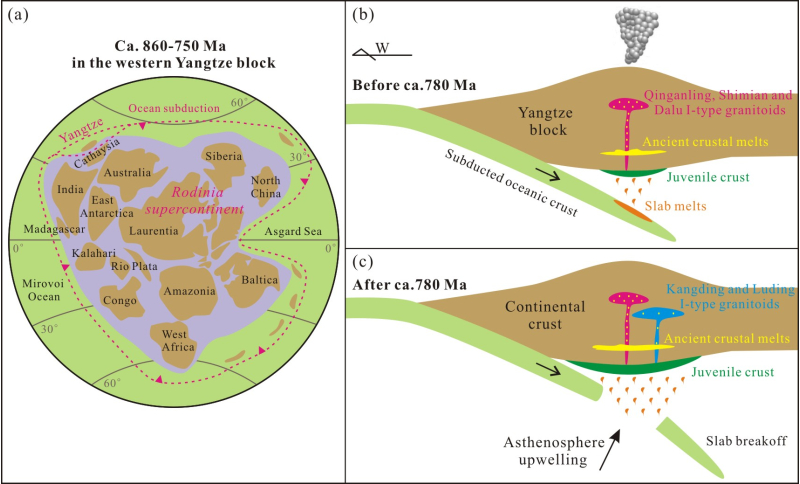
Compositional variations of Neoproterozoic I-type granitoids in response to slab breakoff in the western Yangtze block, South China
ABSTRACT

The Neoproterozoic western Yangtze block is a vital area for understanding geodynamics of the Rodinia supercontinent. In order to explore temporal and compositional variations of I-type granitoids in this region, we present zircon U-Pb-Hf isotopes and bulk rock geochemical data of the Shimian monzogranite and Kangding tonalite. They yield emplacement ages of 827 ± 5 Ma and 757 ± 3 Ma with εHf(t) values ranging from 6.8 to –1.1 and 9.6 to 3.6, respectively. Typical peraluminous and high-temperature minerals, such as garnet and pyroxene, are scarce. The characteristics of low A/CNK, Ga/Al and FeOT/MgO ratios, as well as low zircon saturation temperatures (770–660°C) can be identified from the granitoids, suggest a typical I-type granite origin. They have variable Y/Nb ratios of 6.18–1.76, Mg# values of 44.3–14.2, and εHf(t) values of 9.6 to –1.1, which can be explained by a heterogeneous source primarily comprising juvenile crust with minor ancient crustal components. Elemental correlations are indicative of fractional crystallization, such as Fe-Ti oxides and plagioclase. In comparison, regional I-type granitoids have geochemical diversities which are bounded by ca. 780 Ma, e.g., contrasting SiO2 contents (average 71.78 wt.% vs. 63.79 wt.%), Y/Nb ratios (average 3.91 vs. 3.49), Rb/Sr ratios (average 1.52 vs. 0.13), Mg# values (average 27.9 vs. 43.6) and εHf(t) values (average 4.84 vs. 7.76). All these evidences suggest a different participation of juvenile crust in their source region before and after ca. 780 Ma. Combined with previous studies, we propose an arc affinity for the Neoproterozoic granitoids in this region, and a slab breakoff on ca. 780 Ma responsible for their compositional variations.
KEYWORDS
I-type granitoids, zircon U-Pb-Hf isotopes, arc magmatism, slab breakoff, western Yangtze block- Published : 2022
- Released on J-STAGE : 2022/02/28
- Received : 2021/05/08
- Accepted : 2021/09/24
- DOI : https://doi.org/10.2343/geochemj.GJ22002
- J-STAGE URL : https://www.jstage.jst.go.jp/article/geochemj/56/1/56_GJ22002/_article/-char/ja
- J-Online ISSN: 1880-5973
- Print ISSN : 0016-7002
- ISSN-L : 0016-7002
All Issues
- Vol.59, 2025
- Vol.58, 2024
- Vol.57, 2023
- Vol.56, 2022
- Vol.55, 2021
- Vol.54, 2020
- Vol.53, 2019
- Vol.52, 2018
- Vol.51, 2017
- Vol.50, 2016
- Vol.49, 2015
- Vol.48, 2014
- Vol.47, 2013
- Vol.46, 2012
- Vol.45, 2011
- Vol.44, 2010
- Vol.43, 2009
- Vol.42, 2008
- Vol.41, 2007
- Vol.40, 2006
- Vol.39, 2005
- Vol.38, 2004
- Vol.37, 2003
- Vol.36, 2002
- Vol.35, 2001
- Vol.34, 2000
- Vol.33, 1999
- Vol.32, 1998
- Vol.31, 1997
- Vol.30, 1996
- Vol.29, 1995
- Vol.28, 1994
- Vol.27, 1993
- Vol.26, 1992
- Vol.25, 1991
- Vol.24, 1990
- Vol.23, 1989
- Vol.22, 1988
- Vol.21, 1987
- Vol.20, 1986
- Vol.19, 1985-1986
- Vol.18, 1984
- Vol.17, 1983
- Vol.16, 1982
- Vol.15, 1981
- Vol.14, 1980
- Vol.13, 1979
- Vol.12, 1978
- Vol.11, 1977
- Vol.10, 1976
- Vol.9, 1975
- Vol.8, 1974
- Vol.7, 1973
- Vol.6, 1972-1973
- Vol.5, 1971
- Vol.4, 1970-1971
- Vol.3, 1969-1970
- Vol.2, 1968
- Vol.1, 1966-1967




